Nage is the term (French word) for a flavored liquid used for poaching delicate foods, typically seafood. A traditional nage is a broth flavored with white wine, vegetables, and herbs, in which seafood is poached. The liquid is then reduced and thickened with cream and/or butter. [1]
Cooking something à la nage translates as “while swimming” (French nage) and refers to cooking in a well-flavored court-bouillon. [2] Eventually the term "nage" itself came to refer to a broth which, while light, is strong enough to be served as a light sauce with the dish itself, [3] unlike a court-bouillon which is omitted. Additional ingredients such as tomatoes are sometimes added. [1]

Cajun cuisine is a style of cooking developed by the Cajun–Acadians who were deported from Acadia to Louisiana during the 18th century and who incorporated West African, French and Spanish cooking techniques into their original cuisine.
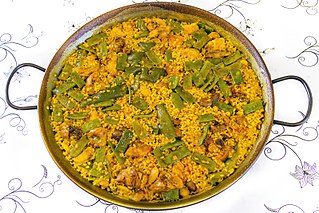
Paella is a rice dish originally from Valencia. While non-Spaniards commonly view it as Spain's national dish, Spaniards almost unanimously consider it to be a dish from the Valencian region. Valencians, in turn, regard paella as one of their identifying symbols. It is one of the best-known dishes in Spanish cuisine.

Poaching is a cooking technique that involves heating food submerged in a liquid, such as water, milk, stock or wine. Poaching is differentiated from the other "moist heat" cooking methods, such as simmering and boiling, in that it uses a relatively lower temperature. This temperature range makes it particularly suitable for delicate food, such as eggs, poultry, fish and fruit, which might easily fall apart or dry out using other cooking methods. Poaching is often considered a healthy cooking method because it does not use fat for cooking or flavoring the food.

In cooking, a sauce is a liquid, cream, or semi-solid food, served on or used in preparing other foods. Most sauces are not normally consumed by themselves; they add flavor, moisture, and visual appeal to a dish. Sauce is a French word taken from the Latin salsa, meaning salted. Possibly the oldest recorded European sauce is garum, the fish sauce used by the Ancient Romans, while doubanjiang, the Chinese soy bean paste is mentioned in Rites of Zhou in the 3rd century BC.

Louisiana Creole cuisine is a style of cooking originating in Louisiana, United States, which blends West African, French, Spanish, and Amerindian influences, as well as influences from the general cuisine of the Southern United States.
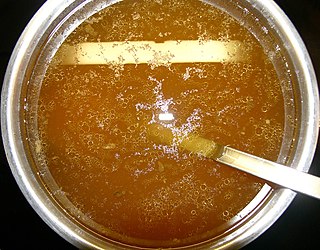
Broth, also known as bouillon, is a savory liquid made of water in which meat, fish or vegetables have been simmered for a short period of time. It can be eaten alone, but it is most commonly used to prepare other dishes, such as soups, gravies, and sauces.

Stock, sometimes called bone broth, is a savory cooking liquid that forms the basis of many dishes – particularly soups, stews, and sauces. Making stock involves simmering animal bones, meat, seafood, or vegetables in water or wine, often for an extended period. Mirepoix or other aromatics may be added for more flavor.

Bouillabaisse is a traditional Provençal fish soup originating in the port city of Marseille. The French and English form bouillabaisse comes from the Provençal Occitan word bolhabaissa, a compound that consists of the two verbs bolhir and abaissar.
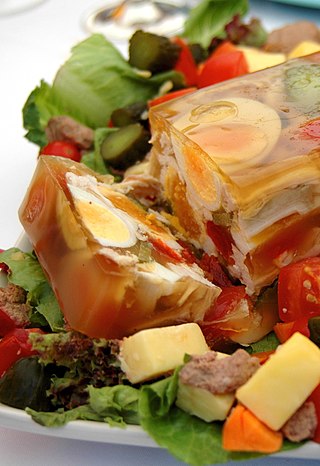
Aspic or meat jelly is a savory gelatin made with a meat stock or broth, set in a mold to encase other ingredients. These often include pieces of meat, seafood, vegetable, or eggs. Aspic is also sometimes referred to as aspic gelée or aspic jelly. In its simplest form, aspic is essentially a gelatinous version of conventional soup.

A velouté sauce is a savory sauce that is made from a roux and a light stock. It is one of the "mother sauces" of French cuisine listed by chef Auguste Escoffier in the early twentieth century, along with espagnole, tomato, béchamel, and mayonnaise or hollandaise. Velouté is French for 'velvety'.

Court-bouillon or court bouillon is a quickly-cooked broth used for poaching other foods, most commonly fish or seafood. It is also sometimes used for poaching vegetables, eggs, sweetbreads, cockscombs, and delicate meats. It includes seasonings and salt but lacks animal gelatin.
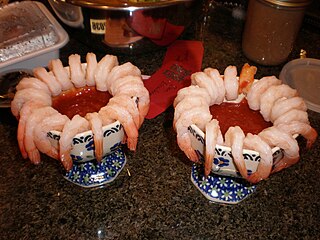
Cocktail sauce, also known as seafood sauce, is one of several types of cold or room temperature sauces often served as part of a dish referred to as a seafood cocktail or as a condiment with other seafoods. The sauce, and the dish for which it is named, are often credited to British celebrity chef Fanny Cradock, but seafood cocktails predate her 1967 recipe by some years.

A bouillon cube, stock cube, or broth cube (Asia) is dehydrated broth or stock formed into a small cube about 13 mm wide. It is typically made from dehydrated vegetables or meat stock, a small portion of fat, MSG, salt, and seasonings, shaped into a small cube. Vegetarian and vegan types are also made. Bouillon is also available in granular, powdered, liquid, and paste forms.

The following outline is provided as an overview of and topical guide to food preparation:
A master stock or master sauce is a stock which is repeatedly reused to poach or braise meats. It has its origins in Chinese cuisine and is typically used in Cantonese and Fujian cuisines. Foods poached or braised in the master stock are generally referred to as lou mei.
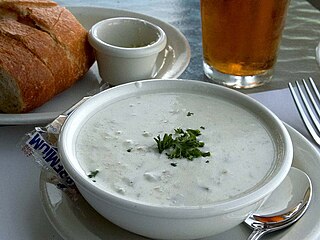
Fish soup is a food made by combining fish or seafood with vegetables and stock, juice, water, or another liquid. Hot soups are additionally characterized by boiling solid ingredients in liquids in a pot until the flavors are extracted, forming a broth.

Soup is a primarily liquid food, generally served warm or hot, that is made by combining ingredients of meat or vegetables with stock, milk, or water. Hot soups are additionally characterized by boiling solid ingredients in liquids in a pot until the flavors are extracted, forming a broth. Soups are similar to stews, and in some cases there may not be a clear distinction between the two; however, soups generally have more liquid (broth) than stews.

Stock pot is a generic name for one of the most common types of cooking pot used worldwide. A stock pot is traditionally used to make stock or broth, which can be the basis for cooking more complex recipes. It is a wide pot with a flat bottom, straight sides, a wide opening to the full diameter of the pot, two handles on the sides, and a lid with a handle on top.
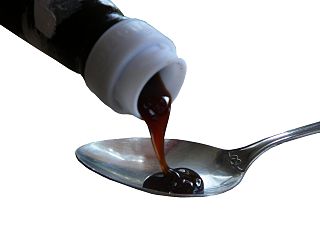
Oyster sauce describes a number of sauces made by cooking oysters. The most common in modern use is a viscous dark brown condiment made from oyster extracts, sugar, salt and water thickened with corn starch. Some versions may be darkened with caramel, though high-quality oyster sauce is naturally dark. It is commonly used in Chinese, Thai, Malay, Vietnamese, and Khmer cuisine.